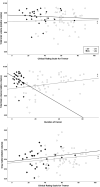Artificial-intelligence-based MRI brain volumetry in patients with essential tremor and tremor-dominant Parkinson's disease
- PMID: 37946794
- PMCID: PMC10631860
- DOI: 10.1093/braincomms/fcad271
Artificial-intelligence-based MRI brain volumetry in patients with essential tremor and tremor-dominant Parkinson's disease
Abstract
Essential tremor and Parkinson's disease patients may present with various tremor types. Overlapping tremor features can be challenging to diagnosis and misdiagnosis is common. Although underlying neurodegenerative mechanisms are suggested, neuroimaging studies arrived at controversial results and often the different tremor types were not considered. We investigated whether different tremor types displayed distinct structural brain features. Structural MRI of 61 patients with essential tremor and 29 with tremor-dominant Parkinson's disease was analysed using a fully automated artificial-intelligence-based brain volumetry to compare volumes of several cortical and subcortical regions. Furthermore, essential tremor subgroups with and without rest tremor or more pronounced postural and kinetic tremor were investigated. Deviations from an internal reference collective of age- and sex-adjusted healthy controls and volumetric differences between groups were examined; regression analysis was used to determine the contribution of disease-related factors on volumetric measurements. Compared with healthy controls, essential tremor and tremor-dominant Parkinson's disease patients displayed deviations in the occipital lobes, hippocampus, putamen, pallidum and mesencephalon while essential tremor patients exhibited decreased volumes within the nucleus caudatus and thalamus. Analysis of covariance revealed similar volumetric patterns in both diseases. Essential tremor patients without rest tremor showed a significant atrophy within the thalamus compared to tremor-dominant Parkinson's disease and atrophy of the mesencephalon and putamen were found in both subgroups compared to essential tremor with rest tremor. Disease-related factors contribute to volumes of occipital lobes in both diseases and to volumes of temporal lobes in essential tremor and the putamen in Parkinson's disease. Fully automated artificial-intelligence-based volumetry provides a fast and rater-independent method to investigate brain volumes in different neurological disorders and allows comparisons with an internal reference collective. Our results indicate that essential tremor and tremor-dominant Parkinson's disease share structural changes, indicative of neurodegenerative mechanisms, particularly of the basal-ganglia-thalamocortical circuitry. A discriminating, possibly disease-specific involvement of the thalamus was found in essential tremor patients without rest tremor and the mesencephalon and putamen in tremor-dominant Parkinson's disease and essential tremor without rest tremor.
Keywords: Parkinson’s disease; artificial intelligence; brain volumetry; tremor.
© The Author(s) 2023. Published by Oxford University Press on behalf of the Guarantors of Brain.
Conflict of interest statement
All authors declare no conflict of interest related to this study. Ullrich Wüllner served as consultant and lecturer and on advisory boards for Bayer AG, STADA Pharm and Zambon; he received grants from the Federal Ministry of Education and Research (BMBF), the German Research Foundation (DFG) and the Deutsche Parkinson Vereinigung e.V.
Figures




References
-
- Rizzo G, Copetti M, Arcuti S, Martino D, Fontana A, Logroscino G. Accuracy of clinical diagnosis of Parkinson disease: A systematic review and meta-analysis. Neurology. 2016;86(6):566–576. - PubMed
-
- Schrag A, Münchau A, Bhatia KP, Quinn NP, Marsden CD. Essential tremor: An overdiagnosed condition? J Neurol. 2000;247(12):955–959. - PubMed
-
- Helmich RC, Toni I, Deuschl G, Bloem BR. The pathophysiology of essential tremor and Parkinson's tremor. Curr Neurol Neurosci Rep. 2013;13(9):378. - PubMed
-
- Hoshi E, Tremblay L, Féger J, Carras PL, Strick PL. The cerebellum communicates with the basal ganglia. Nat Neurosci. 2005;8(11):1491–1493. - PubMed
LinkOut - more resources
Full Text Sources
